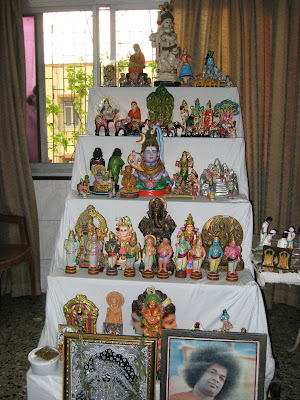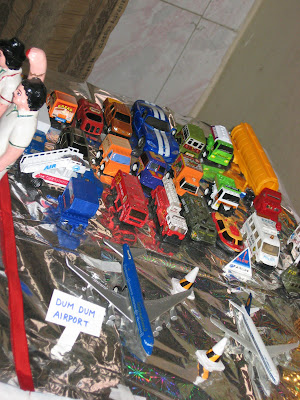The absence of ancient Hindu structures in Kashi is something I have always lamented about. The shrines are certainly ancient, and that is something that has always attracted me to the city. However, I miss the beauty of the ancient structures that we see at other sites. This feeling is intensified when I see marble and concrete and tiles in temples that once would have been beautifully adorned with evocative sculptures, and worn by the passage of time, touched by the hands of seekers who came before. This time , this desire to see some remnants of an ancient Hindu structure in Kashi came true when I managed to visit the Kardameshwar Temple. The Kardameshwar temple is not one of the main temples in the city. It is part of the temples on the Pancha Kroshi yatra, a pilgrimage which takes one on a circumambulatory tour of the whole city. The temple is located on the outskirts of the city, on the western bank of a tank called the Kardama Kund. The Kardameshwar temple is one of the...
Weekends during Navaratri are busy, for these are the days of hectic socializing – these are the days we have more visitors at home, and we have to go to others’ houses as well. At least, Samhith was happy as he got to see a lovely golu at one of our friends’ houses. They also have a young son, and he had enthusiastically exhibited a cricket team as well an airport.
Navaratri is a time we pay obeisance to the Devi in her each and every form. It was one such form that was depicted in the temple on Saturday, the fifth day of Navaratri – SAKHAMBARI.
In the Devi Mahatmyam, Durga prophesies that when the earth has been dry for a hundred years, the wise ones who continuously meditate upon her will cause her to be born in a superhuman fashion and she will bring forth from her body; fruits, flowers, vegetables and herbs to take away our hunger and thirst and our fear of death. She calls herself SHAKAMBARI. We pray to her for abundance of fruits and vegetables.
She is depicted as being covered with fruits and vegetables, and as you can see from the photograph, apart from the face, every inch of the Devi is made up of vegetables, including the decoration around her.
Sunday, the 6th day, which signifies the completion of the phase celebrating Lakshmi, had a decoration that pleased Samhith very much – GANDAKI Devi of Muktinath.
The Gandaki Devi temple is at Muktinath in Nepal, and is one of the 51 Shakti Peethams. It is believed that Sati’s nose fell at this place.
The Devi has been depicted as holding in her hands, two heads, one of a male, and the other a female, and standing on another figure.
Samhith got all excited, and shouted out “Mamma look! The Devi has killed three asuras!” (He notices only asuras these days, not the gods). The temple priest hastened to correct him, saying that the Devi was not holding the auras’ heads, but the bad thoughts and bad habits of normal people like us, which is what we should pray to her for – an explanation which he accepted for the moment, though not full satisfied yet. He wants me to find out who those asuras are, and I must say, till now I have been unsuccessful. Even the internet, which provides most of the answers to my son’s questions, has let me down. If any of you reading this has any more information about this form of the goddess, please do let me know.
That’s all I have for the moment. Looking forward to sharing more news with all of you tomorrow….
 |
| From Miscellaneous |
 |
| From Miscellaneous |
 |
| From Miscellaneous |
Navaratri is a time we pay obeisance to the Devi in her each and every form. It was one such form that was depicted in the temple on Saturday, the fifth day of Navaratri – SAKHAMBARI.
 |
| From Miscellaneous |
In the Devi Mahatmyam, Durga prophesies that when the earth has been dry for a hundred years, the wise ones who continuously meditate upon her will cause her to be born in a superhuman fashion and she will bring forth from her body; fruits, flowers, vegetables and herbs to take away our hunger and thirst and our fear of death. She calls herself SHAKAMBARI. We pray to her for abundance of fruits and vegetables.
 |
| From Miscellaneous |
She is depicted as being covered with fruits and vegetables, and as you can see from the photograph, apart from the face, every inch of the Devi is made up of vegetables, including the decoration around her.
Sunday, the 6th day, which signifies the completion of the phase celebrating Lakshmi, had a decoration that pleased Samhith very much – GANDAKI Devi of Muktinath.
 |
| From Miscellaneous |
The Gandaki Devi temple is at Muktinath in Nepal, and is one of the 51 Shakti Peethams. It is believed that Sati’s nose fell at this place.
The Devi has been depicted as holding in her hands, two heads, one of a male, and the other a female, and standing on another figure.
 |
| From Miscellaneous |
Samhith got all excited, and shouted out “Mamma look! The Devi has killed three asuras!” (He notices only asuras these days, not the gods). The temple priest hastened to correct him, saying that the Devi was not holding the auras’ heads, but the bad thoughts and bad habits of normal people like us, which is what we should pray to her for – an explanation which he accepted for the moment, though not full satisfied yet. He wants me to find out who those asuras are, and I must say, till now I have been unsuccessful. Even the internet, which provides most of the answers to my son’s questions, has let me down. If any of you reading this has any more information about this form of the goddess, please do let me know.
That’s all I have for the moment. Looking forward to sharing more news with all of you tomorrow….
Comments
Post a Comment
Thanks so much for stopping by. Please leave a comment for me so that I will know you have been here....